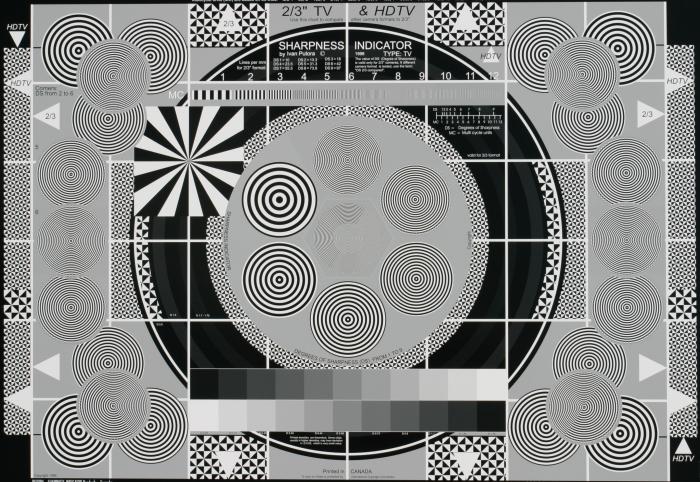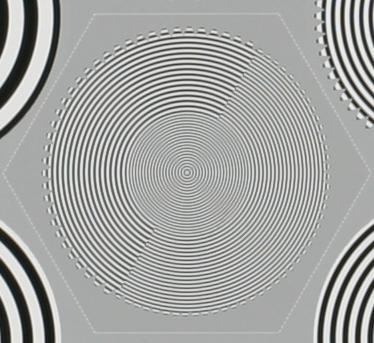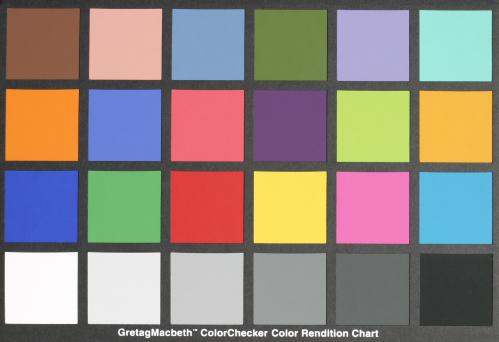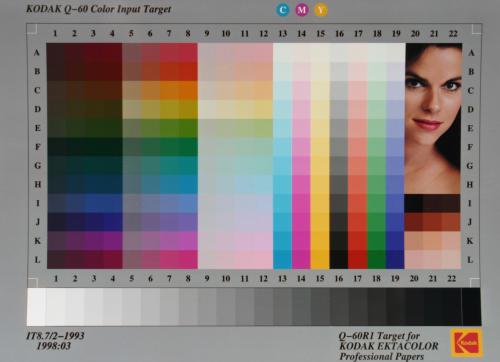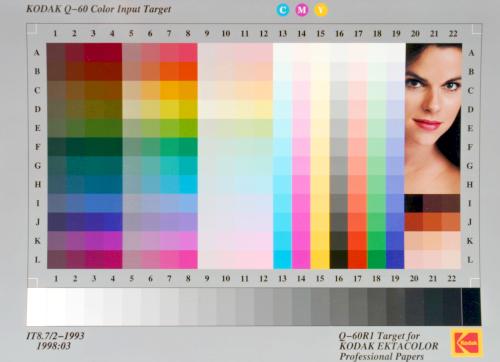|
|||||||
|
On the Bench Using a Putora Sharpness Chart, I took photos in full sunlight, using the AF Mode (green rectangle setting) on the camera (the camera chooses settings for everything). Results are shown below. First is a photo of the whole chart, with the only modifications being reduction in size for publication here. The exposure was f/11 at 1/350th second and the lens was set to 40mm focal length.
The resulting photo is sharp even on the edges. At the top of the photo is a resolution bar, which indicates resolution of 10 lines per millimeter to 97 lines per millimeter, when you take the photo with the white triangles at the edges of the field of view. This chart is designed for high definition digital video cameras, so the aspect ratio (16:9) is not quite the same as the 10D (1.5:1). So, I lined it up such that the side triangle points were touching the edges of the viewfinder, and the top and bottom triangles were just inside the viewfinder. Below is the resolution bar, shown in two pieces, without reduction. As you can see, the 10D resolution begins to deteriorate at about 9, which means the resolution of this lens and sensor would be 70 lines per mm (when the chart is framed within the viewfinder as mentioned, the sensor would have 70 lines per mm focused on it from the chart through the lens, and this would be the highest number of lines that the sensor can resolve). However, this is only the case when the film plane is 60 x the focal length from the test chart (the standard testing distance). In our case, since this would be 2.4 meters, or 7.9 feet, and would compress the ability to see resolution down to much lower levels, we will standardize our test so that the chart is photographed filling the viewfinder. For the 10D, the photographing distance was 42% of that 60x distance, and as such, the resolution is 42% of 70 lines/mm, or 29.4 lines/mm. Since most digital camera reviews in other publications do not test the resolution, and this is Secrets' first camera review, it is difficult to say whether this performance is good or not. Once we have other reviews published, this test will be more meaningful.
Below is the center circle area of the sharpness chart. Notice that the lines are smooth, and without apparent artifacts. It is shown without reduction in size, but there is additional compression in the cropping and jpg storage, so you can imagine how good the original is.
Below is the gray scale section of the sharpness chart, reduced slightly, for reproduction here. You can see that the full scale shows up very well, but the contrast is reduced such that the white (top right, bottom left) is somewhat gray. Digital SLRs apparently tend to keep the image low contrast, and also a bit soft (no sharpening in the camera in default setting). The idea is that you can boost contrast and sharpen the photos with your graphics software, e.g., PhotoShop and PhotoImpact, such as I have done in the second photo. This way, you don't have any lost highlights or shadows in the master graphic file, nor any edge enhancements that can't be gotten rid of.
A Macbeth Color Checker was then photographed. This chart is an industry standard. The exposure was f/11 at 1/250th second. The resulting photo is slightly overexposed, but the colors are accurate in terms of their tonality. It is reduced in size for reproduction. The second photo is a scanned version of the Color Checker where I made adjustments to have it look as close to the original (on my calibrated Sony computer monitor) as possible.
For another test, I used the Kodak Q-60 Color Input Target, which has standard skin tones. At the green rectangle setting (AF Mode), the camera chose f/9.5 and 1/250th second, and the results are shown below, The first photo is with no post-adjustments (except for cropping and size). The second photo is the camera photo with some processing for brightness, contrast, and saturation. The third photo is a scanned version, adjusted to look as close to the original as possible.
Conclusions The Canon EOS-10D is a spectacular camera. It has all the features of film SLRs plus those that are for digital photography. It goes way beyond point and shoot technology, and gives you the means to take photos only limited by your imagination. The best part about this, to me, is that I can use all my older Canon EOS lenses and accessories. At $1,499 (street prices are coming down fast, I have seen it for $1,199 lately), it is still well within the budget of most amateur photographers. If you are a Canon SLR user, and are in the market for a digital camera, the 10D is a must-see. But even if you don't have a bag full of Canon lenses or accessories, the 10D is so good, it still should be on your short list for digital camera shopping. Part I - Introduction and Features Part III - On the Bench and Conclusions
- John E. Johnson, Jr. -
|
|||||||

